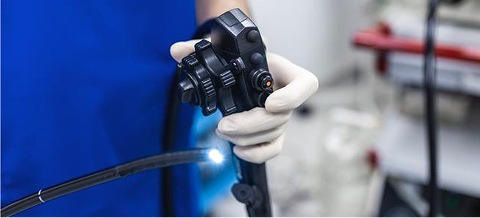Surgical Endoscope System
The 3D/4K/ICG Surgical Endoscope System, Image1 S™ Rubina® at Burjeel Medical City represents the latest in minimally invasive surgical technology. This cutting-edge system combines high-resolution 4K imaging, 3D visualization, and near-infrared fluorescence (ICG) imaging to provide surgeons with enhanced precision and clarity during complex procedures. The integration of 3D/4K technology allows for superior depth perception, while the ICG fluorescence feature helps visualize blood flow and tissue perfusion in real-time. These advanced capabilities make it valuable in a wide range of surgical specialties, including gastrointestinal, gynecologic, thoracic, and neurosurgical procedures.
Key Features.
Enhanced Color
Display
The system provides vibrant color representation and real-time visualization, allowing surgeons to differentiate between healthy and diseased tissues more easily. This is particularly beneficial in complex surgeries.
Multispecialty Application
The versatility of the Image1 S™ Rubina® system makes it suitable for a wide range of surgeries, including gastrointestinal, liver, gynecologic, thoracic, and neurosurgical procedures. This adaptability ensures the system can be used in various disciplines to improve patient outcomes.
ICG Fluorescence Imaging
This system includes Indocyanine Green (ICG) fluorescence technology, which enables real-time visualization of blood vessels, lymph nodes, and bile ducts. It helps surgeons identify abnormal tissues and ensure complete tumor removal or precise treatment in other types of procedures.
3D Visualization
The 3D technology allows for enhanced depth perception, enabling surgeons to perform more precise dissection and tissue manipulation during minimally invasive procedures, improving both accuracy and safety.
4K Ultra-High-Definition Imaging
The system delivers crystal-clear 4K UHD resolution, providing exceptional detail that helps surgeons visualize fine anatomical structures during surgery, ensuring precision and better treatment outcomes.
Conditions Treated Using the Image1 S™ Rubina® System.
The Image1 S™ Rubina® system is used in a variety of minimally invasive surgeries, including but not limited to:

- Colorectal surgery (including colon and rectal cancer)
- Liver surgery (including hepatocellular carcinoma and metastases)
- Pancreatic surgery
- Gynecologic surgeries (e.g., ovarian, endometrial, and cervical cancer)
- Lung and thoracic procedures
- Neurosurgery
- Esophageal surgery
- Biliary tract and gallbladder surgeries
- Minimally invasive biopsies and tumor resections
Benefits of the Image1 S™ Rubina® System.
Patients undergoing surgery with the 3D/4K/ICG Surgical Endoscope System benefit from its advanced visualization and imaging capabilities:

Enhanced Tumor Visualization
The ICG fluorescence feature allows surgeons to visualize blood flow and tissue perfusion in real-time, ensuring more accurate tumor resections and reducing the risk of leaving abnormal tissue behind.
Superior Depth Perception
The 3D technology provides enhanced depth perception, allowing surgeons to perform more precise dissections and reduce the risk of injury to surrounding healthy tissues.
Minimally Invasive Approach
The system is used in minimally invasive surgeries, reducing the size of incisions, minimizing post-operative pain, and promoting faster recovery.
Improved Detection of Lymph Nodes
ICG fluorescence helps surgeons identify and remove lymph nodes more accurately, improving surgical outcomes, particularly for cancers that have spread.
Reduced Risk of Complications
The enhanced visualization and precision provided by the Image1 S™ Rubina® system reduce the risk of complications, such as damage to surrounding organs or structures.
Increased Accuracy in Complex Surgeries
The system’s combination of 4K resolution and fluorescence imaging allows for greater accuracy in complex surgeries, improving long-term outcomes.
Our Approach to Minimally Invasive Surgery.
At Burjeel Medical City, the Image1 S™ Rubina® system plays a crucial role in our minimally invasive surgical approach to care. Here’s how we apply this technology:

Multidisciplinary Collaboration
Our team of surgeons, gastrointestinal surgeons, gynecologic oncologists, thoracic surgeons, radiologists, and medical oncologists work together to develop personalized treatment plans using this advanced technology.
Minimally Invasive Techniques
We prioritize minimally invasive surgery whenever possible, utilizing the advanced visualization provided by the 3D/4K/ICG system to ensure precise tumor removal and better patient outcomes.
Real-Time Decision Making
The real-time imaging and ICG fluorescence capabilities enable surgeons to make immediate, informed decisions during surgery, improving safety and reducing the likelihood of complications.
Focus on Recovery and Outcomes
Our minimally invasive approach, supported by advanced imaging technology, helps patients recover faster and achieve better surgical outcomes, while maintaining high standards of precision and care.
Patient Journey.
Patients undergoing minimally invasive surgery with the Image1 S™ Rubina® system at Burjeel Medical City can expect a supportive, patient-centered experience:
-

Initial Consultation
A thorough consultation with the surgical team to assess the patient's condition and determine if surgery using the 3D/4K/ICG system is appropriate for their needs.
-

Pre-Surgical Imaging and Planning
Pre-operative imaging studies and diagnostics are performed to guide the surgical plan, ensuring the most precise approach with advanced visualization.
-

Minimally Invasive Surgery with Image1 S™ Rubina®
During surgery, the system provides real-time 3D and 4K visualization, as well as ICG fluorescence imaging, to guide the surgeon in tumor removal and tissue preservation.
-

Post-Surgical Monitoring
After surgery, patients receive comprehensive post-operative care, including follow-up imaging and regular monitoring to ensure a successful recovery.
-

Post-Surgical Care
Personalized recovery plans are provided, along with follow-up appointments to monitor long-term outcomes and address any concerns during the healing process.